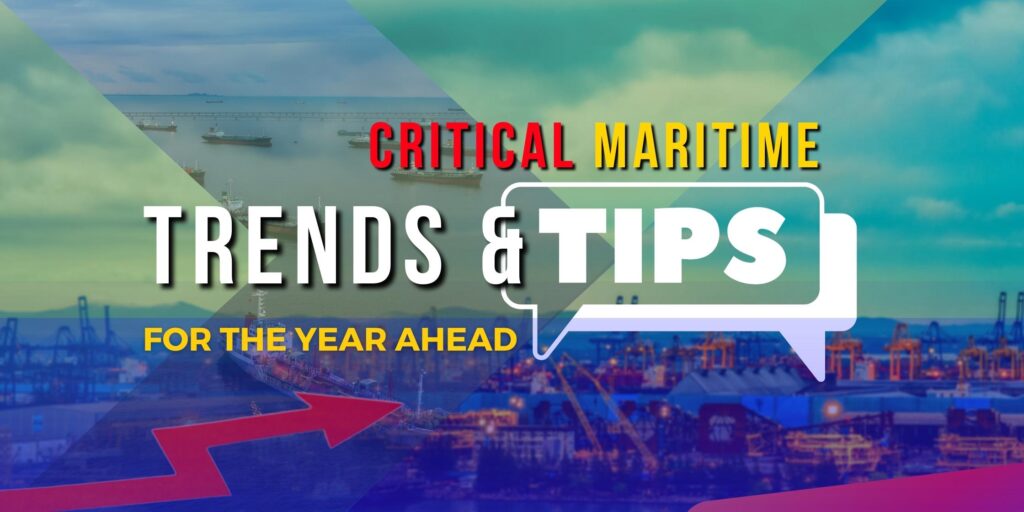For the maritime industry, the year 2023 has started to become the year of resilience. Several businesses are facing challenges amidst the global economic slowdown, geopolitical changes, and disruption in supply chains.
“The maritime sector is known for its ability to adapt to the changing tides, and the years ahead are no different.”
I have had the opportunity to observe various aspects of the maritime industry because of my association with this industry for twenty-eight years. I would like to share some of the critical maritime trends and tips that have caught my attention at present, through this blog.
Trend 1: Sustainability at its peak!
“The future of the seas lies in sustainability.” It is my responsibility to emphasize the growing importance of eco-friendly practices in the industry. With increasing pressure to reduce emissions and minimize the environmental impact, adopting alternative fuels like LNG and exploring hybrid propulsion systems will be a game-changer in the upcoming years.
I always like to tell my students and other associates that it is extremely important to make it a personal mission to integrate sustainable practices, from implementing energy-efficient technologies to reducing single-use plastics on board.
Trend 2: Digitalisation and Autonomous shipping
If you are associated with the maritime industry, you might have noticed that the digital revolution has started to hit the shores. Maritime companies are increasingly investing in data analytics, IoT, and autonomous shipping solutions to enhance efficiency and safety.
By the next year, you can expect to see more autonomous vessels navigating the seas, supported by real-time data analytics for smarter decision-making. It’s a remarkable transformation, but it also means staying updated with the latest tech is a must for maritime professionals.
Trend 3: Introduction of cybersecurity at sea
Always remember that “With great connectivity comes great responsibility.”
The maritime industry is becoming more vulnerable to cyberattacks, and it’s crucial to safeguard ships and shore-based systems from potential threats. Regular training and cybersecurity drills are essential to protect our vessels from digital pirates.
Trend 4: Port Automation and Efficiency
The face of ports is changing rapidly. As I visited the Port of Odesa, Ilyichevsk, and Yuzhniy, one of the busiest trade ports in the world, I could see the impact of automation.
I felt like “Automation has become the key for the maritime industry for staying competitive,”
Automated cranes, smart containers, and streamlined cargo handling are not just buzzwords; they’re essential for meeting growing demands and reducing turnaround times. It’s time for port authorities and shipping companies to invest in such innovations.
Trend 5: Climate Resilience and Preparedness
Climate change is increasingly influencing the maritime industry. More intense storms and unpredictable weather patterns demand better preparedness. I have witnessed that several captains insist that “being climate-ready can be a lifesaver.”
Improved weather forecasting, enhanced vessel design for extreme conditions, and the development of emergency response plans are vital steps in ensuring maritime operations remain resilient. Hence, to remain prepared for the high seas, predictive technologies are currently playing crucial roles in the maritime industry.
My tips for navigating the maritime industry in the upcoming years:-
Here are some helpful hints for those working in the maritime industry as we head into a new era of digitalization and automation in the maritime industry:
Acknowledge Sustainability: Make the effort to lessen the environmental impact of your ship. On board, think about cutting waste, optimizing routes, and implementing alternate fuels.
Remain Tech-Aware: Stay up to date with the newest electronic devices and tools. They can increase safety, increase efficiency, and assist you in making well-informed decisions.
Make cybersecurity a priority: To protect against cyber threats, provide your crew with cybersecurity training and put strong security measures in place aboard your ship.
Simplify the Processes: Investigate efficiency and automation strategies to cut expenses and speed up port turnaround times.
Get Ready for Climate-Related Challenges: Take the initiative to adjust to climate change. Make sure your ship and journey plan is ready for harsh weather by keeping up with weather forecasts.
“We sail together into uncharted waters, and the key to our success lies in our ability to adapt and innovate. Smooth seas may not make skillful sailors, but informed and proactive mariners can navigate any storm.”
Training sessions:
If you’re eager to stay ahead in the ever-evolving maritime industry and ensure your preparedness for the future, I invite you to join my professional training sessions. With a unique blend of industry facts and my extensive maritime experience, these sessions will provide valuable insights into the critical aspects of the maritime sector. Gain the knowledge and skills required to navigate the upcoming trends, enhance sustainability, and excel in this dynamic field. Don’t miss this opportunity to learn from a seasoned expert and equip yourself for success in the maritime industry.
Conclusion
As I sail through these transformative times in the maritime industry, I’m reminded of the industry’s resilience and its capacity to embrace change. We mariners are the stewards of the seas, and by staying informed and adapting to these critical trends, we can ensure a safer, more sustainable, and efficient maritime future for 2023 and beyond.
So, here’s to a prosperous and exciting 2023 for the maritime world, where tradition meets innovation on the open seas.


